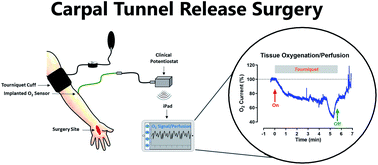Development and validation of a real-time microelectrochemical sensor for clinical monitoring of tissue oxygenation/perfusion†
Abstract
Oxygen is of critical importance to tissue viability and there is increasing demand for its reliable real-time clinical monitoring in order to prevent, diagnose, and treat several pathological disorders, including hypoxia, stroke and reperfusion injury. Herein we report the development and characterisation of a prototype clinical O2 sensor, and its validation in vivo, including proof-of-concept monitoring in patients undergoing surgery for carpal tunnel release. An integrated platinum-based microelectrochemical device was custom designed and controlled using a miniaturised telemetry-operated single channel clinical potentiostat. The in vitro performance of different sensor configurations is presented, with the best sensor design (S2) displaying appropriate linearity (R2 = 0.994) and sensitivity (0.569 ± 0.022 nA μM−1). Pre-clinical validation of S2 was performed in the hind limb muscle of anaesthetised rats; tourniquet application resulted in a significant rapid decrease in signal (90 ± 27%, [ΔO2] ca. 140 ± 18 μM), with a return to baseline within a period of ca. 3 min following tourniquet release. Similar trends were observed in the clinical study; an immediate decrease in signal (39 ± 3%, [ΔO2] ca. 30 ± 20 μM), with basal levels re-established within 2 min of tourniquet release. These results confirm that continuous real-time monitoring of dynamic changes in tissue O2 can serve as an indicator of reperfusion status in patients undergoing carpal tunnel surgery, and suggests the potential usefulness of the developed microelectrochemical sensor for other medical conditions where clinical monitoring of O2 and perfusion is important.

- This article is part of the themed collection: Bioanalytical sensors for real world applications


 Please wait while we load your content...
Please wait while we load your content...